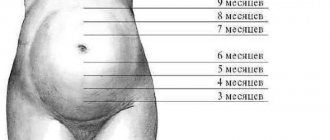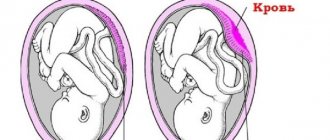How does a doctor manage a pregnancy?
You continue to see the doctor once a month, although sometimes doctors switch to a schedule of one visit every three weeks. This can happen between 25 and 34 weeks.
- At appointments, as before, the doctor will measure your abdominal circumference, your weight, pulse, and blood pressure.
- The doctor also measures the height of the uterine fundus, which can now be felt at the level of the navel or slightly higher. At 24 weeks, this figure is 20–24 cm.
- At 24 to 28 weeks, your doctor will take a urine test to monitor your glucose levels.
- You may also be asked to test your Rh status to avoid fetal and maternal blood conflicts.
Possible problems
The most common problem at this stage is anemia. Due to the intensive growth of the fetus and the constant increase in blood volume, the concentration of iron in the blood decreases.
With severe iron deficiency, premature birth may occur. Signs of anemia:
- frequent dizziness;
- nausea;
- fast fatiguability;
- fainting;
- dyspnea;
- sleep and appetite disturbances;
- impaired sense of smell;
- unusual taste preferences;
- deterioration of the condition of the skin, nails and hair.
Some women are diagnosed with kidney problems. Due to a violation of the amount of fluid, the outflow of urine may decrease, which leads to its stagnation and the occurrence of pyelonephritis. Medications may be prescribed to correct the problem. If the problem is ignored, it can lead to a deterioration in the general condition and the onset of premature labor.
The most serious complication of pregnancy is insufficiency of the isthmic-cervical canal. This pathology leads to the opening of the uterus ahead of schedule. At 21-24 weeks, to eliminate the problem, a special operation is performed to place a suture on the cervix.
After the procedure, the pregnant woman is prescribed special medications to prevent an increase in uterine tone. The expectant mother is observed in the hospital for 7 days. After the operation, slight bleeding is possible due to damage to the cervix, but within a few days it completely disappears.
How the female body changes
1. How weight is gained. As a rule, by the 6th month the expectant mother gains at least 5 kg. Now the weight will not grow abruptly, but smoothly and steadily - approximately 250 g per week. By the end of the second trimester, you will have crossed the weight gain mark of 6 kg. These are average values for a woman with a normal body mass index.
2. New sensations in the eyes. Your eyes may become light sensitive and may feel dry and feel like there is sand in them. Don't worry, this is a normal pregnancy condition called dry eye syndrome. Try to give your eyes rest more often and maintain their hygiene. If this sensation noticeably bothers you, you can wipe your eyes with a cotton pad dipped in warm water or instill special moisturizing drops. Also, vision may temporarily deteriorate, but this will pass.
3. The feeling of your body changes. As your body's center of gravity gradually shifts, you may feel more clumsy and clumsy. Don't worry, this is temporary.
4. How hair and nails change. You may also notice that not only your hair, but also your nails began to grow faster, and at the same time they changed their structure - they became either stronger or more brittle.
5. Increase in foot size. Don't be surprised, but your feet may increase by half a size or even a whole size. Such changes are not associated with swelling, which you may also experience during this period: physiological swelling is usually localized in the ankle area.
The main reason for the increase in leg size is this: under the influence of hormones, the muscles and ligaments in your body begin to lose their elasticity and do not support the bones that surround them as firmly. Choose the most comfortable shoes for yourself, taking into account the fact that in the evening your feet will require more freedom than in the morning. After the baby is born, clothing and leg sizes will gradually return to their previous parameters.
6. Digestion. In addition to the growth in leg size, you can observe the consequences of a general hormonal change for your body in other parts of the body: the intestines lose the intensity of their motility, pain appears on the sides of the abdomen associated with stretching of the muscles of the abdominal wall.
All these symptoms will go away after childbirth, for now you need to be calm and patient.
Child development in the sixth month
If you now look at your child using an ultrasound, you can see that he still has little body fat and seems very thin. Every movement of the child reverberates with kicks and blows for the pregnant woman. But this is already a real person, his arm and leg muscles are well developed, you feel that his kicks have already become quite noticeable. You will be very surprised, but a child in the sixth month of pregnancy can already cough and sneeze. Soon the eyes, now still closed with film, will open completely, and your baby will see. He already hears music well and distinguishes a variety of sounds. From sharp, very loud music, the child shudders and behaves restlessly. He may already frown if he doesn’t like something in your behavior, he may clench his fist and open his mouth. Don't assume that your baby sleeps at the same time as you. Your sleep cycles may not be the same. When you are sleeping, the child can be awake and vice versa. By the sixth month of pregnancy, children already weigh more than half a kilogram, and their height, as a rule, exceeds 30 cm.
As soon as you are in a relaxed state, resting, the child’s activity increases. He begins to push, encouraging you to move and oxygenate your blood. Its movements are also active after you have eaten, because during this period the sugar level in the mother’s blood increases. If you are worried, the level of adrenaline in the blood increases - and this also forces the child to increase his physical activity. The baby already has his own “character”, one is calmer and slower, and the other is a complete fidget. Therefore, two women who are approximately the same month pregnant can exchange their feelings and find out that they are completely opposite. But if your child was active and then “calmed down” for a long time, this is a reason to urgently consult a doctor; cessation of physical activity can be a serious sign. For especially suspicious pregnant women, it can be suggested to carry out full control over the intrauterine movement of the fetus. It is necessary to count all the movements that the child makes during the day. On average, a child makes 10 movements in 10 minutes. Here you need to count all movements, both subtle and strong. If there is less movement than expected, try eating something and lying down. Pos
How the tummy grows
At the 6th month, the skin on the abdomen stretches and may begin to itch. In addition, as pregnancy progresses, the likelihood of developing stretch marks on the abdomen, chest and thighs also increases.
- Exercise, a special maternity bra, a bandage that supports the abdomen from below, and a moisturizer (or better yet, a special stretch mark cream for pregnant women) can somewhat reduce the likelihood or severity of this phenomenon. While waiting for a baby, stretch marks sometimes have a darker color than the skin in neighboring areas. After birth, they will begin to lighten and over time will differ in color from darker, unaffected skin.
- In the second and especially in the third trimesters, you may experience pain in the lower abdomen. The abdominal muscles and ligaments that support the growing uterus stretch and pull apart as it grows. This cannot but cause sensations ranging from tingling to nagging pain on the sides of the abdomen. They can occur and intensify when changing body position, sudden movements and physical activity. With such pain, changing posture, switching to another type of activity, rest and a warm bath help well.
- Although this doesn't happen to all women, you may also notice an unusual sensation in your lower abdomen where it becomes "rocky" for a few seconds. These are false contractions, or Braxton-Hicks training contractions, - irregular contractions of the muscles of the uterus and cervix preparing for childbirth. Spasms can occur up to 4 times an hour and last from 15 to 30 seconds, but in some mothers they can be longer - up to 2 minutes.
- It is important to remember that training contractions should not be painful, although - and this depends on the woman’s pain sensitivity - they can cause some discomfort. Another important difference between false contractions and labor is the lack of dynamics in the frequency and duration of muscle contractions.
- During Braxton Hicks contractions, doctors recommend sitting up, placing your feet on an elevated platform, and drinking a glass of water. Such recommendations are due to the fact that, according to observations, training contractions intensify in mothers who lead a very active lifestyle, as well as in those whose bodies experience mild dehydration.
Feelings of the expectant mother
With a normal pregnancy, there will be no significant changes in your well-being in the sixth month. The expectant mother will feel good and enjoy future motherhood, watching the growth of her tummy and the movements of her little one. At the same time, the still expanding belly does not greatly restrict movement, and even the choice of a dowry is still ahead. If you already know the gender of the baby, you can also think about choosing a name for him.
One of the most pleasant sensations will be the movement of the fetus; now its movements are distinctly strong, the baby can push, toss and turn and fuss in the stomach. Watch his movements; active movements that are too rare or too frequent may indicate discomfort for the baby and require the attention of doctors.
You may feel slightly tired from the state of pregnancy, and the woman may be distracted and forgetful. In the sixth month, minor, unpleasant pain in the back or area under the ribs may occur. This occurs as a result of tension in the uterine ligaments and muscle stretching, as well as some softening of the spine and joints.
The increase in the volume of blood that circulates through the vessels can give a feeling of sweating and heat, and sometimes there may be a feeling of nasal congestion and even nosebleeds due to swelling of the mucous membrane. Bleeding and increased sensitivity of the gums may occur, which can be due to a lack of vitamins and hormonal changes in the mucous membranes. There is an increase in the amount of fluid in the body, increased urine output and increased pressure from the uterus on the bladder, which leads to more frequent trips to the toilet, and sometimes when sneezing or coughing, involuntary release of a few drops of urine may occur, especially when the bladder is full.
The load on the legs increases, which can lead to swelling and cramps of the calf muscles; you need to rest your legs more often by raising them above body level on a pillow or headboard. If you are prone to varicose veins, elastic bandages or tights may be recommended. Swelling in the arm area may occur with pain and discomfort, and crawling. Edema occurs due to the accumulation of fluid in the body, and because of this, compression of the nerve roots occurs. Numbness of the hands and crawling sensations are unpleasant, but not dangerous for the pregnant woman and the fetus.
One of the problems of this month may be digestive disorders associated with flatulence, constipation and heartburn, and the main thing in getting rid of such problems is the refusal of provoking foods that cause disturbances in the functioning of the intestines or stomach, a complete and rational, healthy diet. If you have constipation, there is a high risk of developing a pathology such as hemorrhoids in pregnancy, which is very unpleasant and painful. And naturally, one of the unpleasant things will be the itching of the skin of the abdomen, due to stretching of the tissues. It's not worth it, you need to use moisturizing, soothing skin care products. I may experience stretch marks, which can be helped by special creams and wearing a bandage.
How to reduce leg cramps
What can you do to prevent leg cramps?
- Stretching exercises. Maybe the ones you perform in the gymnastics complex for pregnant women are enough. If this kind of exercise is not there, then you can do the following. Stand at arm's length from the wall, rest your palms against it. Lean towards the wall, bending your elbows so that the distance is halved. Keep your heels off the floor, count to 10, return to the starting position and relax to the count of “5.” Repeat 3 times.
- Alternate periods of mobility and rest, while sitting, raise your legs and let them rest at a height no lower than the one at which you are sitting.
- Wear compression stockings, knee socks, and tights.
- Drink enough fluids - at least 1.5 liters per day, which is equivalent to 8 glasses.
- Your diet should contain foods that provide calcium and magnesium to your body.
Here's what you can do if your muscles are already cramping:
- stretch your leg, try to stretch the cramped muscle with soft stroking;
- straighten your leg and pull your foot towards you several times;
- take a warm shower - this will relax your muscles;
- apply a hot or cold compress to your leg;
- lightly but perceptibly prick the muscle at the site of the spasm with something sharp, but so as not to injure yourself. Please do not attempt to use anything too sharp or non-sterile, such as pins or needles.
What weeks are included in the sixth month
The issue of calculating the gestational age in months is quite controversial. The thing is that while ordinary people count the prescribed “9 months” according to the calendar (a calendar month, as a rule, is more than 28 days, 4 weeks), obstetricians count 10 obstetric months, exactly 4 weeks each. The confusion that arises becomes incredibly worse towards the end of the term, which is why you are unlikely to hear from your doctor your term in monthly terms - they prefer to use calculations in weeks, which is more accurate.
There is another controversial issue in obstetrics regarding timing - the presence of two “reference points” - from conception and from the date of the last menstruation - embryonic and obstetric weeks are considered respectively. Obstetricians use the method of the same name - obstetric.
So, next we will talk about the 6th obstetric month, which includes the period from the 21st to the 24th obstetric weeks. The place of the sixth obstetric month in the calendar of pregnancy trimesters is towards the end of the second trimester (it ends with the 26th obstetric week).
What can pregnant women eat in the 6th month?
Vegetables, fruits, cereals, nuts, eggs, dairy products, vegetable oils, lean meats and sea fish provide the body with all the necessary nutrients.
- The B vitamins found in brown rice and lentils help relieve constipation.
- Calcium in milk and fermented milk products strengthens your teeth and provides building material for fetal bones.
- The fiber in vegetables and fruits fights constipation by speeding up the passage of food through the intestines, while vitamin C improves your resistance to infections.
- Vitamin E, contained in sunflower oil and nuts, strengthens the walls of blood vessels and makes the blood less viscous, and this is important for the normal delivery of oxygen and nutrients to the cells by the blood.
Don't forget that if you experience bouts of heartburn, the right diet can help you: eat 5-6 times a day in small portions, exclude spicy, salty and fried foods from your diet. It is also advisable not to eat before bed.
Multiple pregnancy
If in the case of a singleton pregnancy the belly grows from week to week, then when carrying several babies its size can change before our eyes, from day to day. Therefore, you should not be surprised that at the 6th month of pregnancy, the stomach is covered with stretch marks and no amount of oils and creams will save you from this. The increased load on the entire body cannot ignore the appearance of a woman. The waist is smoothed out, and the belly can no longer be hidden and it noticeably reminds others that in front of them is a pregnant woman.
For an expectant mother expecting twins or triplets, this period becomes a real test. She gets tired faster, and the sensations from walking may become less pleasant. It is worth using a prenatal bandage to lighten your burden, do not overwork, and, if possible, rest at the first signs of fatigue. As babies move, the shape of the abdomen may change, for example, if they take a transverse position. What does the belly look like at 6 months pregnant in this case? Most likely, it will look like an oval, however, this phenomenon is temporary. Since there is still some time ahead, it is likely that they will take the correct position before the onset of labor and the stomach will have a more familiar rounded shape.
What physical activity to choose
Pregnancy often makes a woman feel less energetic. Regular exercise can give you a boost of energy for the whole day, improve the mood with which you live it, help you go to bed easier, sleep well and start a new day fully recovered. Exercise prepares your body for labor by shortening the duration of contractions, reducing the likelihood of using stimulants, and increasing your physical endurance. We talk in detail about sports while expecting a baby here.
Exercise during pregnancy helps reduce the severity of typical problems of expectant mothers: gas, constipation, hemorrhoids, varicose veins, cramps and swelling of the legs.
Before you start engaging in any physical activity, you should consult your doctor. Knowing your history and observing your current condition, he can give some recommendations regarding the types of physical activity that are preferable for you.
In the 6th month of pregnancy, you can engage in the following types of physical activity:
- race walking;
- swimming;
- fitness;
- jogging (until the end of the second trimester);
- dancing (no jumping);
- Pilates;
- yoga;
- exercises for pregnant women on a fitball;
- in the winter - leisurely skiing.
Exercises on a fitball for pregnant women (a gymnastic ball for fitness) are very good: they not only keep the body muscles toned, but also relieve tension in the lower back that is growing every week. Gymnastics for pregnant women, which is offered by many sports clubs and classes in preparation for childbirth, includes:
- general strengthening set of exercises;
- ball exercises;
- stretching elements;
- breathing exercises for pregnant women;
- special exercises to train the pelvic muscles.
How does the fetus develop?
The fetus looks like a smaller copy of a person, all its organs are fully formed, subcutaneous fat begins to form, which helps maintain a constant body temperature. The body length at the beginning of the month is 31 cm, by the end - 36 cm, the weight increases from 400 g to 800 g, that is, it practically doubles. If the baby is born as a result of preterm labor by the end of the 6th month, there is an 85% chance that the baby will survive. While his respiratory system is undeveloped, there is no surfactant in his lungs - a substance that prevents the lungs from collapsing when exhaling.
The fetal brain develops so intensively that the number of its cells and connections between them reaches a maximum. The unborn child has a stable pattern of sleep and active wakefulness, which continues during the newborn period. The movements of the hands and fingers become more and more dexterous, a preference for one of the hands is observed, that is, whether the child will be right-handed or left-handed can be predicted in advance. He dreams and hears the speech of his parents, reacts to bright light and to the touch of a cold sensor during an ultrasound.
The heart rate is up to 160 beats per minute, the heartbeat can be clearly heard using an obstetric stethoscope. On an ultrasound, it is noticeable that the child makes movements that imitate breathing. These movements are not able to carry out gas exchange, but they train the lungs, blood vessels and respiratory muscles. At the same time, fetal circulation develops and blood flow into the child’s cardiovascular system increases.
The fetal genitals continue to develop, girls have a fully formed vagina, and the testicles of a male fetus are lowered into the scrotum.
Childbirth preparation courses
You may have already started taking classes to prepare for childbirth; if not, it’s time to choose the program that suits you. Ideally, such courses should provide you with comprehensive information about:
- psychology and physiology of childbirth;
- correct behavior at each stage;
- breathing and relaxation techniques;
- newborn care skills;
- breastfeeding;
- gymnastics for pregnant women;
- diet of pregnant and nursing mothers.
In addition to the informational benefits, such courses help to provide psychological preparation and reduce the level of anxiety, uncertainty and fears associated with childbirth and the future role of a parent. During the classes, you can ask any questions you are interested in and will receive not only a competent answer from an expert, but also psychological support from other group members.
The following circumstance is also important: if you attend classes with your husband, he will gain more self-confidence, because soon he will have to cope with a new task for him - helping you in childbirth and providing all possible assistance after the birth of the baby.
When choosing courses, take into account a set of factors, including territorial and financial (free courses from a antenatal clinic or commercial courses in a private school), but the main criterion, undoubtedly, is the level of training and specialization of the presenters. Thus, gymnastics classes should be conducted by a sports trainer, lectures on childbirth should be given by an obstetrician, a neonatologist (a doctor who deals with newborn children) should talk about postnatal development, and a lactation consultant should talk about lactation.
While you are preparing for upcoming important events, let's find out what stages your child is currently going through in his development.
Checklist for 6 months of pregnancy
- If the stomach periodically pulls, but there are no other unpleasant symptoms, we are talking about training contractions. This is a natural condition that does not advance labor. You can reduce discomfort by performing breathing exercises.
- There is a little more than a month left before maternity leave, discuss its details and timing at work, and clarify what documents you need to bring. Usually this is a sick leave certificate signed by a gynecologist.
- Get a fitball. It is convenient to perform gymnastics for pregnant women on a gymnastic ball; its use helps relieve pain during contractions. It will also be useful after childbirth for rocking the baby and doing exercises with him.
At the end of the 6th month, drowsiness and increased fatigue may become your frequent companions. Take care of yourself! In just 1 month, maternity leave will begin, when there will be more opportunities to relax.









